If you come across black-coloured corn – don’t assume it’s spoiled. This unusual hue belongs to a Peruvian variety of maize. In Europe, it’s quite rare. The unique colour of black corn comes from its high anthocyanin content – natural antioxidants known for their anti-inflammatory and even anti-tumour properties. But what other benefits does Peruvian maize offer? Could it harm your health? And what dishes can you prepare with it? Read on to find out.
Table of contents
Characteristics and Description
Black corn, apart from its colour, looks identical to traditional yellow corn. It has the same cob and kernel structure.
The colour isn’t purely black – it has a purple sheen. When sliced, the kernels may appear bluish, violet, or even yellowish.
Originally, Peruvian indigenous communities cultivated black corn in small cobs, no larger than 4 cm. Through selective breeding, not only were its taste qualities improved, but the plant also grew taller (around 2 m) with larger cobs (up to 30 cm).
In terms of taste, this corn is no different from the sweet corn most Europeans are familiar with.
Note. Anthocyanins – the pigments responsible for blue and purple hues in vegetables, fruits, and berries – are believed to inhibit tumour development in the gastrointestinal tract. However, researchers aren’t yet ready to recommend specific "anti-cancer" foods.
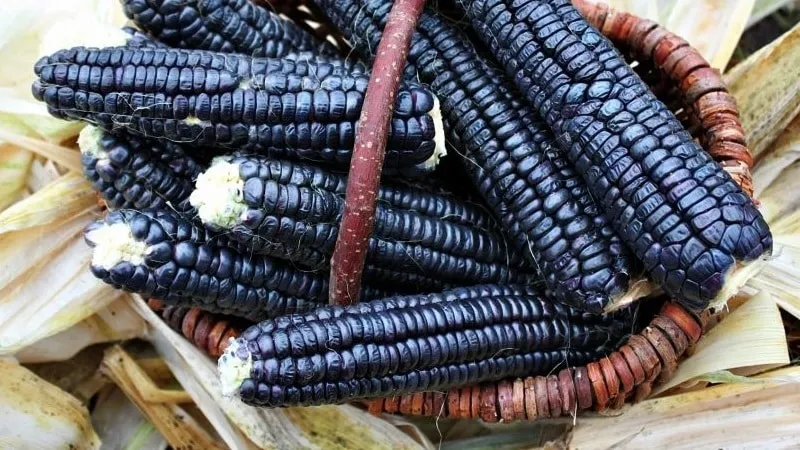
Composition and Properties
Black corn kernels are rich in essential micronutrients:
- Phosphorus;
- Iron;
- Magnesium;
- Calcium;
- Copper;
- Nickel;
- Potassium.
Black maize is also packed with vitamins:
- A;
- B1 and B2;
- C;
- E;
- K;
- PP.
Corn protein contains essential amino acids like tryptophan and lysine, which help combat depression and insomnia effectively.
This grain is high in proteins, fats, fibre, and carbohydrates, yet remains a low-calorie food: just 120 kcal per 100 g. Its carbohydrates stabilise blood sugar levels and provide sustained energy.
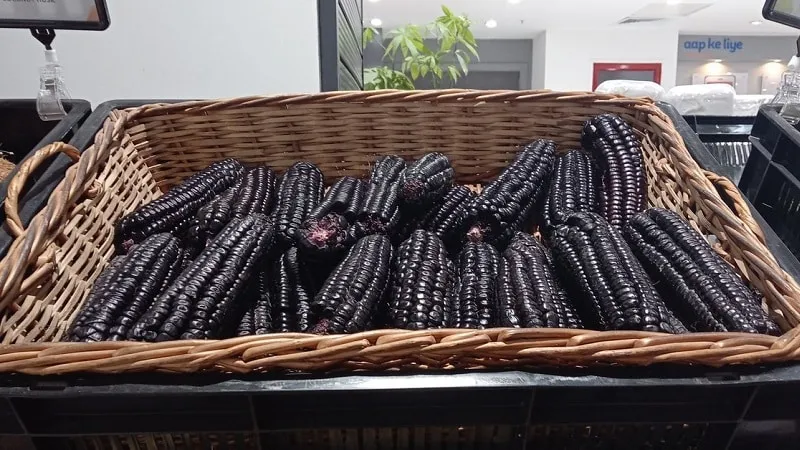
Benefits and Risks
Over 7000 years ago, the Incas, Quechua, and Moche tribes used black corn for medicinal purposes. Modern science confirms its unique composition and positive effects on human health:
- Reduces excess cholesterol.
- Promotes cellular rejuvenation.
- Helps manage stress and insomnia.
- Supports digestive health.
- Regulates metabolism.
- Nourishes muscle tissue.
- Detoxifies the body, removing heavy metals.
- Enhances cardiovascular function.
- Aids in certain liver conditions.
- May lower cancer risk.
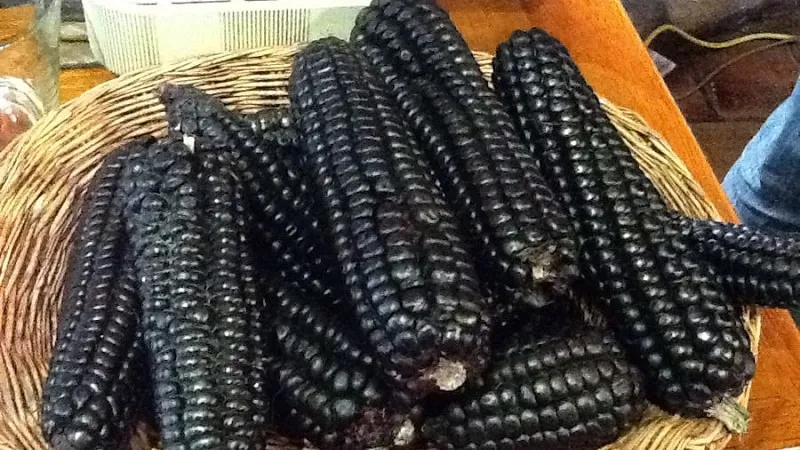
Contraindications
Excessive consumption may cause stomach or intestinal discomfort. It’s also not recommended for individuals with:
- Increased blood clotting tendency;
- Thrombosis risk;
- Thrombophlebitis;
- Gastric ulcers.
Culinary Uses
As mentioned earlier, black corn tastes identical to yellow corn, making it suitable for the same recipes. However, its striking colour can add visual appeal to salads, side dishes, and other meals.
It can be boiled, baked, canned, or eaten raw. The kernels can also be dried and ground into homemade cornmeal.
Traditional Peruvian Recipe – "Mazamorra Morada" Pudding
This pudding is prepared like a thick jelly.
Ingredients:
- 1 kg black corn;
- 3 cloves;
- 3 cinnamon sticks;
- 1 pineapple;
- 1 Granny Smith apple;
- 1 quince;
- 1 lime;
- ½ cup dried apricots;
- ½ cup dried cherries;
- 1 star anise;
- 2 tbsp stevia;
- 1 tsp ground cinnamon.
Preparation:
- Thoroughly wash the corn and fruits (including peels – even the pineapple).
- Chop the apple and quince into large pieces, keeping skin and seeds. Peel the pineapple but reserve the skin. Cut corn cobs into sections.
- Combine all chopped fruits, pineapple skin, and corn in a large pot. Add 9 cups of water.
- Add cinnamon sticks, star anise, and cloves. Bring to a boil and simmer for 15 minutes.
- Reduce heat and cook for another 1.5 hours until liquid reduces by a third.
- Strain the liquid and return it to the pot.
- Add chopped pineapple, apricots, cherries, and stevia. Simmer for 20 minutes after boiling.
- Mix cornstarch with cold water and stir into the pot. Cook for 5 more minutes, then remove from heat.
- Add lime juice and mix well.
- Pour into serving bowls, dust with cinnamon. Serve warm or chilled.
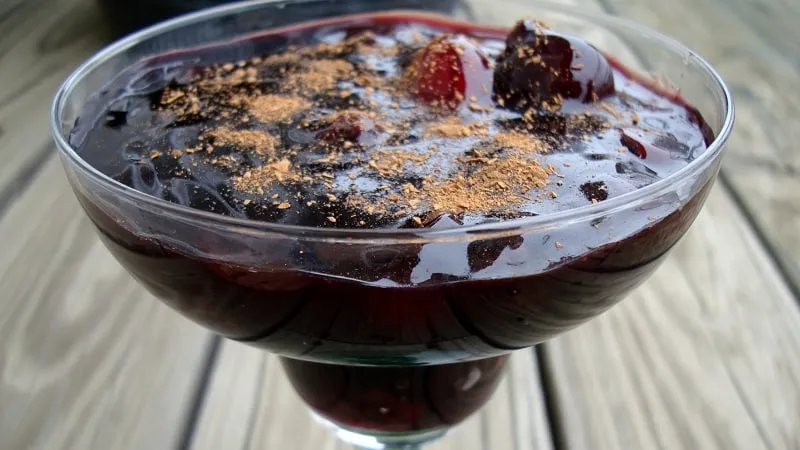
Folk Medicine Applications
In Peru, this grain is valued as a medicinal plant. Powdered kernels are used in tinctures, ointments, and compresses.
"Chicha Morada"
This ancient recipe yields an energising drink that detoxifies, curbs hunger, and improves sleep quality – all while being delicious.
Ingredients:
- 1 kg black corn;
- 600 g pineapple;
- 150 g apples;
- 60 g lemon;
- Sugar, cloves, and cinnamon to taste.
Preparation:
- Wash all fruits and corn.
- Peel the pineapple (reserve the skin). Chop apples roughly.
- Boil apples, corn, pineapple skin, and spices in 4 litres of water until corn kernels begin to split.
- Cool and strain the liquid.
- Add lemon juice and sugar if desired.
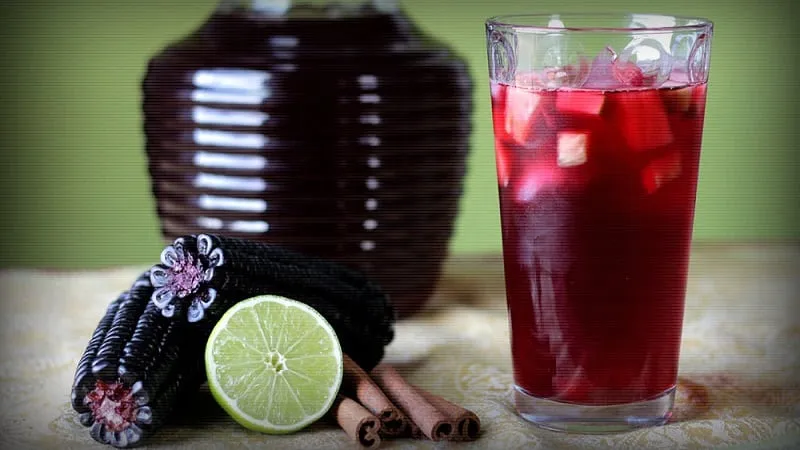
Black Corn Tincture
Used in Peru for lung inflammation, bronchitis, and digestive issues. Always consult a doctor before use!
Dosage: 30 drops diluted in pineapple juice, twice daily 15 minutes before meals.
Ingredients:
- 200 g black corn;
- 500 ml vodka.
Preparation:
- Cut cobs into pieces.
- Place in a glass jar and cover with vodka.
- Store in a dark place for one week.
- Strain before use.
Corn Silk Infusion
This calming drink may help dissolve kidney stones and benefits those with hypertension or atherosclerosis.
Ingredients:
- 100 g corn silks;
- 1 cup boiling water.
Preparation:
- Pour boiling water over silks.
- Cool to room temperature and strain.
- Take 3 tbsp every four hours.

Cultivation and Care
Originating in South America, this plant thrives in similar conditions. It cannot tolerate frost and prefers temperatures of 20-24°C. While challenging to grow in cooler European climates, it may succeed in Mediterranean regions with proper care.
Seed preparation is crucial. Soak them for five days in a wood ash solution (2 tbsp ash per 1 litre water). Ideal planting sites follow legumes, cabbage, or tomatoes.
Sow seeds in April at 8 cm depth. Harvest occurs 85-120 days after sprouting, depending on growing conditions.
Tip. Zinc, molybdenum, and superphosphate fertilisers can help adapt the plant to non-native environments.
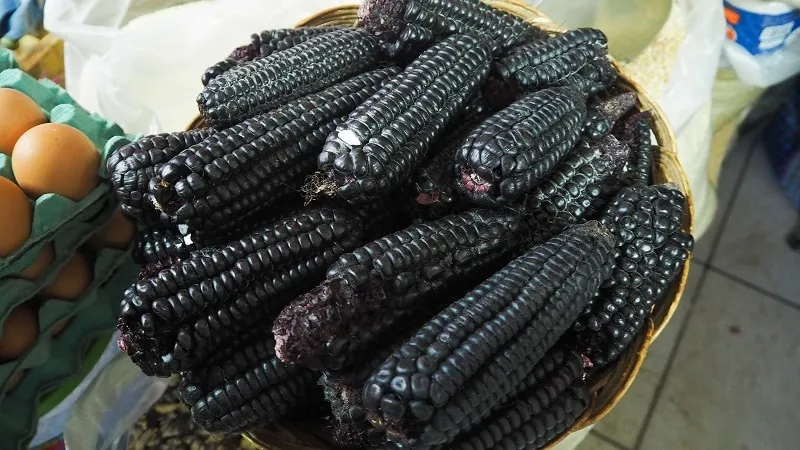
Conclusion
Black corn is an exceptionally nutritious exotic grain. Its benefits are backed by centuries of use in South America, where it serves both as food and medicine. Authentic Peruvian recipes featuring tropical fruits and spices offer invigorating effects and promote holistic healing.







